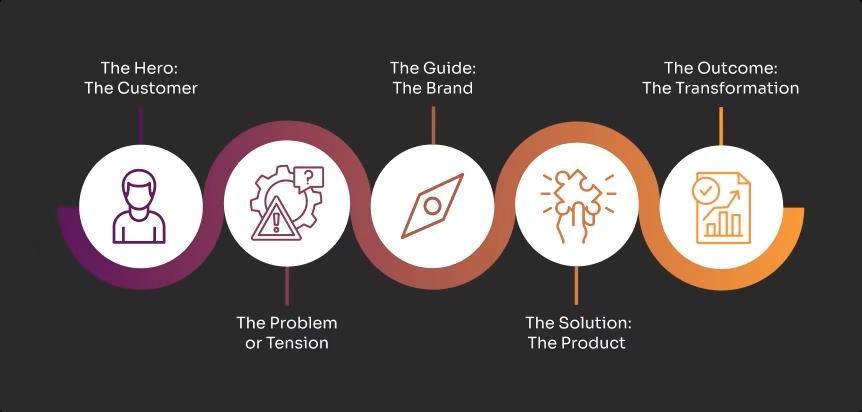
E-commerce has become a crowded stage where every brand is shouting features, discounts, and delivery times. What separates the brands that earn genuine loyalty from those that fight for clicks is the ability to make people care. This is where product storytelling earns its place.
As we step into 2026, AI-driven search and smarter comparison tools make it tougher for brands to stand out. That’s why a clear, well-told story has become one of the few things customers genuinely remember.
Storytelling in product marketing gives context to an item, not as another SKU in a catalog, but as a meaningful part of someone’s lifestyle or identity.
Consumers who shop online are experienced, informed, and used to seeing polished pages. They have learned to ignore generic messaging. They respond to something else entirely: a story that mirrors their own goals, challenges, or values. Product storytelling creates relevance, helps people remember a brand, and builds trust in a way product specifications cannot.
This article explains what product storytelling is, why it works, and how e-commerce brands can use it to build stronger loyalty and achieve long-term growth. The focus is on practical strategies and insights tailored for leaders who already understand the fundamentals of online store marketing and want to elevate their next stage of growth.
What Is Product Storytelling?

Product storytelling is the practice of presenting a product through a narrative instead of a list of technical points. It introduces context, emotion, and meaning to something that would otherwise be reduced to features.
Standard product copy tends to list details and benefits in a linear fashion. Product storytelling shapes those same details into a journey.
It is not fiction, and it should never stretch the truth. It simply brings real facts together in a way that feels relevant and memorable. It helps customers understand why the product exists, who it’s meant for, and how it fits into a real situation.
In a saturated marketplace, this shift matters because people scroll past information that feels generic. A story creates a moment of recognition. The customer sees their own habits, frustrations, or aspirations reflected back. That moment opens space for interest, and interest opens space for conversion.
Why Storytelling Works: The Psychology Behind It
Human beings process stories differently from raw data. Jennifer Aaker from Stanford University suggests that people remember stories up to twenty-two times more than standalone facts. Memory works better when information is tied to emotion.
A strong product story transports customers into a situation. Psychologists call this narrative transportation. When customers imagine themselves in a scenario, they are more open to new information and more likely to trust the source.
Buying decisions in e-commerce often happen fast, but they still follow emotional cues. When consumers relate to a challenge or transformation, they form a personal connection with the brand.
They see a problem being solved or a desire being met. This link shapes perception and influences how the customer evaluates quality, value, and compatibility with their lifestyle.
Key Elements of an Effective Product Story

A solid product story follows a structure that feels natural to the reader and helps them understand not only what the product does but why it matters in their own life.
The Hero: The Customer
The customer is always the main character. A story lands when the customer sees their own habits, frustrations, or goals reflected in it. This is why sharp buyer personas matter in e-commerce marketing. When brands understand real motivations, daily routines, and hidden objections, the narrative speaks to a specific human being instead of a generic audience. People respond to stories that feel like they were written for them.
The Problem or Tension
Every meaningful narrative has a point of friction. Customers face a challenge they want to fix, an inconvenience they have accepted for too long, or a gap in their routine that slows them down. The more clearly this tension is articulated, the easier it is for the audience to understand the need for a solution. Tension pulls readers in because it reflects something they already know from their own experience.
The Guide: The Brand
The brand steps in as the guide rather than the hero. This keeps the tone grounded and avoids the self-focused style that often weakens product pages. As the guide, the brand offers clarity, direction, and expertise. It shows that it understands the customer’s situation and has the knowledge to help them solve it.
The Solution: The Product
The product appears at the point where the customer is ready to resolve the problem. It becomes a practical tool that helps them move forward. This is where functional benefits matter, not as isolated statements but as part of a meaningful shift in the customer’s journey. The reader should understand exactly how the product works and why it is the most logical fit for their situation.
The Outcome: The Transformation
A strong product story ends with a clear look at what changes after the purchase. This could be an emotional shift, a practical improvement, or a combination of both. Customers want to picture the result: a smoother routine, a solved frustration, or a better way of doing something they already value. Describing this transformation brings the story full circle and gives the product long-term relevance in the customer’s mind.
What Every Strong Product Story Needs (Infographic)

- A clear hero your customer can recognize themselves in
- A simple, relatable problem that creates tension and interest
- A brand positioned as the guide, not the hero
- A product introduced as the practical tool that solves the problem
- A believable outcome that shows how life improves after the purchase
Practical Techniques for Strong Product Storytelling

A powerful story is never an accident. It comes from clear insight, careful language choices, and a consistent narrative that guides the customer from discovery to decision.
1. Start With Real User Insights
The strongest stories come from evidence, not guesswork. Customer interviews, reviews, on-site behavior patterns, and search data reveal what people truly care about. These signals help you understand how customers describe their challenges, what motivates them to act, and what objections hold them back.
Testimonials are especially valuable because customers often phrase their experiences in a way that mirrors how others in your audience think. When a narrative reflects real language and how people act in practice, it feels honest, grounded, and relevant.
2. Use Simple, Human Language
Clear writing is one of the easiest ways to build trust. Customers who know the industry don’t need dramatic claims or heavy jargon. They want straightforward, human language that respects their time.
Simple language keeps the focus on the message and helps readers move through the content without friction. It also makes your story feel closer, more confident, and more intentional.
3. Show, Not Tell
Visual detail makes a story believable. Instead of saying a product is “easy to use” or “high quality,” describe the moment when someone actually uses it. Focus on specific actions, familiar frustrations, and everyday situations. This lets customers picture how the product fits into their routine.
When people can imagine the moment of use, they make decisions faster and with more confidence.
4. Build a Consistent Narrative Across All Touchpoints
A product story should not live only on a product page. It needs to guide the customer across the entire brand experience. This includes landing pages, social posts, ads, emails, and even packaging.
When the tone, message, and core idea stay consistent, recognition grows. Customers begin to associate the brand with a clear point of view, which makes every interaction feel more familiar and dependable. Inconsistency creates friction, while consistency builds trust.
5. Combine Data and Emotion
Emotions open the door. Data keeps it open. A relatable story captures attention, but measurable proof reinforces confidence. Blending both creates a narrative that feels persuasive without being dramatic.
For example, pairing a story about a common customer frustration with real usage statistics or satisfaction data adds weight to the message. It shows that the emotional angle reflects real outcomes, not just clever wording. This balance is especially effective with experienced buyers who value both logic and impact.
Where Product Storytelling Makes the Biggest Impact

A strong narrative becomes even more valuable when placed in the right context, and certain parts of the e-commerce experience amplify that impact more than others.
Product Launches
A thoughtful story can shape a launch into an experience instead of a simple announcement. It helps customers understand why the product exists and what problem it solves before they even look at the technical details. When a launch has a narrative, the product feels intentional and relevant rather than added to the catalog just to fill a gap. This creates anticipation and encourages early engagement.
Landing Pages and Product Pages
This is where customers make the real decision, which is why the structure of the page matters as much as the content itself. A conversion-focused e-commerce website gives space for a story to unfold naturally. Many brands choose to work with experts in e-commerce web development because the right design, hierarchy, and layout support a clear and persuasive narrative. When a page is built well, the story, product details, and conversion path do not compete for attention. They guide the customer forward as a single, cohesive experience.
Brand Videos and Explainers
Visual storytelling has the advantage of speed. A short video can show a real situation, highlight the problem, present the product as the tool, and demonstrate the outcome in a matter of seconds. This reduces hesitation, improves understanding, and gives customers a concrete example of how the product fits into everyday life. For many online shoppers, seeing something in action is more persuasive than reading about it.
Social Media and Community Building
In social media marketing, brands get further when they share more than promotions. Communities take shape around shared experiences, authentic moments, and stories that feel personal. When brands showcase customer journeys, behind-the-scenes development, or founder insights, they create a sense of closeness. This encourages comments, saves, shares, and continued engagement. Over time, it also gives the brand a stronger voice and personality that customers recognize immediately.
How to Create Your Own Product Story

Building a product story is a structured process that turns raw insights into a narrative customers can instantly understand and connect with.
1. Identify the Core Customer
Everything starts with clarity about who the customer actually is. Buyer personas help, but they are only useful when grounded in real behavior. Look at how customers shop, what influences them, and what frustrations they talk about most often. This level of detail keeps the story focused on a real human experience.
2. Define the Main Problem
A strong story always circles back to a clear problem. Identify the specific challenge the customer is trying to solve or the desire they want to fulfil. The problem needs to be simple, relatable, and precise.
3. Position the Brand as the Guide
The brand should support, not overshadow, the customer. Position it as the guide that understands the customer’s situation and has the knowledge to help them navigate it. This creates authority , but also gives the brand a consistent voice throughout the customer journey.
4. Present the Product as the Tool
Introduce the product at the moment it naturally fits into the narrative. Explain how it solves the problem in concrete terms. Show how specific features address specific needs. This is the practical part of the story where the customer connects the dots and sees why the product is a logical solution for their situation.
5. Show the Emotional and Functional Outcome
Customers want to understand not only what the product does, but how it improves their life. Describe the functional improvement and the emotional shift that comes with it. Even small changes can feel meaningful when they address a familiar pain point.
6. Craft a Narrative That Flows Naturally
A compelling narrative does not need to be dramatic or theatrical. It simply needs to follow a clear structure. Start with the customer, introduce the problem, present the guide, show the tool, and end with the transformation. Keep the pacing steady and the language grounded. The simplicity of the structure is what makes the story easy to follow.
7. Test and Refine With Real Customers
Once the story is shaped, test it. Share it with actual customers, gather feedback, and see if it reflects their experience. Adjust the narrative based on what resonates and what feels off. Stories that evolve with audience insight stay relevant and continue to perform well long after launch.
Real-World Examples of Excellent Product Storytelling
Many brands have shown that a well-built narrative can elevate a product, strengthen loyalty, and influence how customers perceive value.
A DTC Brand Using a Founder Story: Glossier
Direct-to-consumer (DTC) brands often rely on founder stories because they reveal the moment a real problem sparked the idea behind the product. These narratives work well when the founder is open about the frustration, failure, or need that pushed them to create a better solution.
Customers respond to this because it feels honest and intentional. They understand why the brand exists, what values shaped it, and why the product was built the way it was.
Glossier built its identity on Emily Weiss’s personal experience with beauty culture and the conversations she started on Into The Gloss. The products didn’t arrive first. The stories did. The brand grew because Weiss talked about real gaps she noticed in the beauty world and created products that responded to those needs. Customers connected with the origin story, which helped Glossier feel personal rather than corporate.
A Lifestyle Brand Using Community-Driven Stories: Lululemon
Lifestyle brands that shift the spotlight onto their customers often build momentum faster than those that talk only about themselves. When brands highlight user-generated content, shared experiences, or long-term customer journeys, they create a sense of belonging. This approach also helps potential customers see themselves reflected in the community, making the product feel more accessible and relevant.
Lululemon’s growth has been shaped by community narratives, from in-store events to ambassador profiles and customer-driven stories about wellness, routine, and mindset. Rather than pushing product features alone, the brand highlights how real people use its products in daily life. These stories help customers feel like part of a larger lifestyle, not just buyers of athletic wear.
A Niche Brand Elevating a Simple Product: Ooni
Some of the most effective product storytelling comes from brands selling everyday items. Instead of relying on complexity or luxury, they elevate the product by focusing on craftsmanship, thoughtful design choices, or the cultural meaning behind it.
This transforms something simple into something worth paying attention to. It proves that product storytelling is not limited to premium or aspirational products. When the narrative is rooted in purpose and detail, even the most straightforward items gain character and emotional weight.
Ooni makes portable outdoor pizza ovens, which is a niche and relatively simple product category. Their storytelling focuses on the craft of home pizza making, the sensory experience, and the joy of gathering people around food. By highlighting design, quality, and the culture around homemade pizza, Ooni has turned a straightforward cooking tool into an aspirational, community-driven product.
Ginger IT Example: Astarta Parfums
Our client Astarta Parfums is a strong example of how a brand can use storytelling to deliver a luxury experience without the luxury price tag. Their narrative focuses on the idea that high-quality fragrance should be accessible to almost anyone, not reserved for an exclusive group. This message resonates because it speaks directly to modern perfume buyers who want sophistication, depth, and identity, but without the traditional markup.
The brand pairs this message with clean, minimal design and a confident tone that avoids pretension. Instead of overwhelming customers with technical notes or industry jargon, Astarta builds stories around mood, personality, and emotional connection. The visual identity supports this by being refined, understated, and elegant, which helps customers instantly understand the intended experience.
By blending accessible pricing with elevated storytelling, Astarta Parfums positions itself close to its audience. Customers feel seen, not intimidated. They can recognize themselves in the stories, which creates trust and makes the brand feel both aspirational and attainable.
SEO Strategies for Story-Driven Product Content

When storytelling is paired with smart SEO practices, it does more than engage readers. It helps search engines understand the depth, relevance, and authority of your product content.
E-commerce SEO gains a real advantage from story-driven content because stories keep people on the page longer, reduce bounce rates, and increase the chances of further interaction. Longer dwell time signals to search engines that the page offers genuine value, which improves visibility and supports long-term rankings.
1. Integrate Keywords Naturally
A well-structured product story creates natural opportunities to use keywords without forcing them into the text. When the narrative reflects real customer behavior and motivations, keywords related to your brand fit naturally into your product marketing strategy. This approach avoids keyword stuffing and keeps the reading experience intact. Search engines reward pages where language flows naturally, especially when the content aligns with user intent.
2. Use Structured Data for Product Pages
Structured data gives search engines the clarity they need to present your products accurately. Adding schema for product details, pricing, reviews, and availability helps your content appear in richer search results. Better search formatting can increase click-through rates and draw higher-intent visitors to your store. When combined with strong storytelling on the page itself, this creates both technical and emotional relevance.
3. Build Internal Links Around Customer Journeys
Internal linking should guide the customer, not distract them. Story-driven pages can link to supporting pages that reflect different stages of the decision-making process. Well-planned internal links help users move from curiosity to evaluation to conversion without friction.
4. Create Topic Clusters
Topic clusters allow you to organize storytelling content around themes that matter to your audience. This can include user personas, motivations behind certain buying decisions, comparison guides, and educational resources. Clustering builds topical authority, which helps search engines understand the depth of your expertise. Over time, this increases ranking stability and strengthens your entire e-commerce SEO ecosystem.
When these SEO principles are in place, the final step is to look at how storytelling supports your broader product experience and shapes the way customers perceive your brand.
Wrapping Up
Product storytelling gives e-commerce brands a way to speak to customers on a deeper level. It shifts the focus from features to meaning, from information to relevance. In a market where consumers compare dozens of similar items within minutes, the story behind the product often becomes the deciding factor.
Brands that adopt this approach move beyond transactional interactions – they create recognition, trust, and genuine loyalty.
Now is the time to review whether your messaging communicates the full value of your brand or simply lists features. A well-crafted story can turn attention into interest, and interest into long-term customers.
Ready to Spice Up Your Product Story?
If your current product stories feel flat, inconsistent, or buried under technical details, this is the moment to elevate them. Strong storytelling performs best when supported by a conversion-focused website and content that reflects real customer intent.
A purposeful site architecture built through expert e-commerce web development can create the space your story needs to land with clarity. And ongoing narrative-driven content, supported by professional content marketing services, can keep your message consistent across product pages, campaigns, and every one of your customer touchpoints.
Ginger IT Solutions works closely with ambitious e-commerce brands that want to build compelling narratives and high-performing websites. If you are ready to strengthen your product stories and improve the customer journey, our team is here to help. Feel free to get in touch and explore how we can support your next stage of growth.

